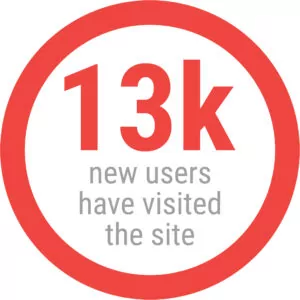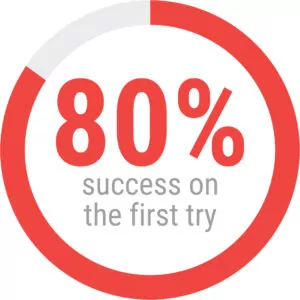How REI took a confusing and cumbersome process of applying for SBIR funding and made it easier and faster for small businesses to commercialize their innovations.
BACKGROUND
The Small Business Administration’s (SBA) Small Business Innovation Research (SBIR) program helps American small businesses engage in Federal Research/Research and Development (R/R&D) with the potential for commercialization. Through a competitive awards-based program, SBIR and STTR enable small businesses to explore their technological potential and provide the incentive to profit from its commercialization. SBIR.gov serves as a gateway for entrepreneurs and researchers to learn about, find, and apply for this funding across a range of federal agencies.
SBIR.gov supports more than 50,000 small businesses and entrepreneurs across the country who rely on SBIR.gov to identify and determine transformative technologies and to build sustainable funding for innovative science and technology ventures.
Some of the transformative technologies that have been funded include the development of the lasers used for eye Lasik surgery. Another innovation was included on the Perseverance Rover on Mars to help understand the geology of Mars.
CHALLENGE
The public website serves as a gateway for entrepreneurs and researchers to learn about, find, and apply for funding across a range of federal agencies. Unfortunately, the website’s lack of user-centered design was making it difficult for users to understand the program and find the information they needed. For example, the website used dense government vernacular instead of plain language that is easily understood. The website wasn’t speaking the language of entrepreneurs or innovators.
The user community had trouble finding information on the site, especially things that would most help them in successfully submitting an award-winning grant proposal like tutorials and training materials. This was supported by Google Analytics which showed low usage of these pages.
SBA also needed to demonstrate a narrative around program successes, especially with a geographic component, since many people had found it difficult to articulate the purpose and impact of SBIR.
SBIR.gov ingests over 100,000 data elements every year in awards, proposals, and solicitations. As the data grows exponentially, the search for faster and filtered results increases, which presents a challenge to the platform. Lastly, the platform had limitations around the data upload process, limiting the number of records that can be uploaded. This made it burdensome for agency users to break down the large data sets into smaller data sets for processing.
REI SOLUTION
Due to an enduring, trusted partnership that spans more than a decade, the SBA enlisted REI to modernize its website. We provided strategy, thought leadership, product management, human centered design, web metrics and analytics, comprehensive search, content management, user support/training, security updates, and web design and development for SBIR.gov, a site that experiences over 2 million visitors a year. From the very beginning, we put the customer first and continued throughout the entire modernization to put the user first.
Better Customer Experience

challenges (to name a few) in web applications is the use of service design. Service design improves the experiences of both the user and employee by designing, aligning, and optimizing an organization’s operations to better support customer journeys. It was using service design principles and techniques that we were able to elucidate SBA’s problem areas and provide convincing artifacts to support the modernization effort produced the
SBIR.gov site.
Some of these “methodologies” we employed were the use of Journey Maps, Personas, Empathy Maps and Card Sorting to inform usage research, ideation, and low-fidelity prototyping of the proposed solution. In this sense, Service Design was as much of a solution as it was as facilitation mechanism for driving other solutions.
Regarding the public user community’s trouble finding pertinent digestible information, we solved this by overhauling the site information architecture with a new simpler navigation menu and layout, driven by user behavior (based on focus group feedback exercises with card sorting). This also led to the easy-to-use, input pattern matching/mapping, local resources search tool for small business users, called Lab to Market Hub.
Telling the narrative around program successes was achieved via our implementation of an impact page and adding a more central geographic component to the community page on SBIR.gov.
REI redesigned the User Interface (UI)/User Experience (UX) and created a mobile-friendly portal and personalized user dashboards that presented key data in visualizations and improved navigation. REI also produced new features that enable users to accomplish tasks more efficiently.
To ensure that these portals and dashboards were following both federal web design and Section 508 accessibility requirements, REI utilized the United States Web Design Standards (USWDS) library. This design library informed decisions on colors, typography, layout, as well as the general look and feel for any custom components or new designs. In addition, the SBA brand guide was referenced to match the visual identity and brand consistency of other SBA products.
Improving Data Management and Search
Our Team had to come up with a more dynamic and stable solution to accommodate the exponential data growth year over year. Our Team overcame the challenge by leveraging the cloud-native search service Elasticsearch. The elastic characteristics allow the search service to auto-scale and accommodate the growth and increased demand without manual intervention. This created a very dynamic and stable search service.
Ensuring High Availability and Scalability

system to support its internal and external stakeholders.
SBIR.gov is a complex, technically sophisticated website. REI created a solution that delivers a dynamic Drupal CMS, supports data ingestion and reporting capabilities, provides a Universal Search capability that allows the solution to auto-scale as the data grows, and easily supports Third-Party integrations. The platform uses AWS Chalice (allowing REI to create and deploy applications quickly), AWS Lambda Virtual functions, and AWS Aurora, and we leverage cloud-native Amazon Search capabilities.
IMPACT
The modernized SBIR.gov saved time, money, and added more user-requested functionality. When the Beta site
In usability testing, our new prototype navigation layout helped users find a given page with 80% success on the
first try as opposed to 35.3% on the legacy website.
REI improved upon the Lab to Market feature which is used to help small businesses find and access non-profit and support resources locally that assist these small businesses with information and guidance in the grant application process. Being in the top 6 most-visited pages on the site, the REI concierge-style tool walks the small business user through a series of quick and easy questions to understand their assistance needs and at the end, provides a targeted list of local resources the small business can use to for assistance in their grant application process, an often time exhausting, intimidating endeavor.
Overall, the modern SBIR.gov solution REI developed took a cumbersome, confusing, and overwhelming process for applying for government funding and made it easier, less frustrating, and faster for small businesses looking to commercialize their innovations.





